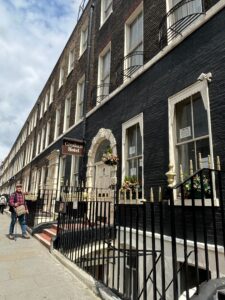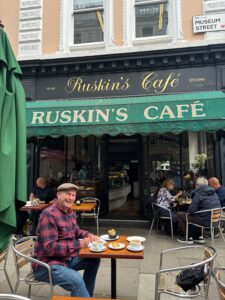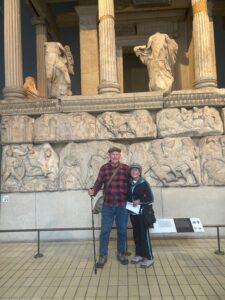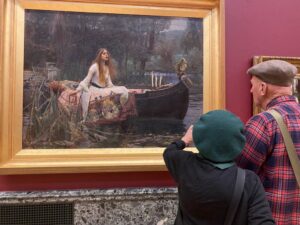
As one does in England, popping up to London for a few days can mean a thousand things – from walking cobbled stones in the steps of the greats of our past to walking past some of the beautiful architecture of our time. It can mean museums and galleries, musicals, historic statues, cornish pastry and having a beer in a corner pub. For Michael and I this time in our 80th year we are slower and not in such a hurry to see and do everything. Hence it means savoring the train trip, finding our gorgeous boutique hotel in the heart of Bloomsbury in the same block as the British Museum surrounded by antiquated book shops, unique pubs, historical buildings once occupied by the likes of Virginia Woolf and TS. Eliot to name two. We enjoyed a leisurely lunch at Ruskins Cafe watching the people, taking in the vibe. London has its Thames-city smell, it congested streets with red buses, black cabs streamin along routes , its crowds of tourists wandering and Aussies like us still bemused by the pomp and ceremony and mesmerised by a history and culture our ancestors left behind long ago .



The British Museum situated in the same block as our accommodation was our afternoon outing.
It is said travel expands ones mind but standing before the Rosetta Stone , before the Greek sculpture of Venus, before the scripted alphabets of the islam world you go deeper amd deeper into the story of humanity.




It has become a ritual on our London visits to walk through the National Gallery and stop before the Sunflowers by Vincent Van Gogh, as one does before a sacred altar , and stop give thanks and remember my Mum, our Nannie who always dreamt to make it ‘overseas’ as we used to call it but didnt and wanted that horizon crossed by every child and grandchild. I also like to sit in the very old brown leather lounge in the Turner room and take in the miracle of light .


Above is my photo of Sunflowers and Joseph Mallord William Turner a scene from Homer’s Odyssey 1829
This trip a special new room called The Last Caravaggio was a new highlight. The painting titled The Martyrdom of Saint Ursula 1610.
This martyrdom takes place in a dark crowded space, Ursula is a lone female figure surrounded ny soldiers, Caravaggio tells the story of her death through a sophistcated interplay of hands: the guilty hands that have just fired the arrow, the outstretched hand of the bystander unable to stop it and Ursula’s hands framing the fatal wound in her chest. Caravaggio includes his own self portrait looking on over the saint shoulder, startingly pale and open moutghed , he makes himself a witness to and perhaps complicent in ursula’s death .
Since the Middle Ages and Hildegard of Bingen, Ursula has been seen as a figurehead for female empowerment.

In the National Portrait Gallery I especially loved spending time with the portraits in the room of The Romantics – Keats, Wordsworth, Coleridge, Shelley, Blake, Loed Byron. We also enjoyed an exhibition called Portraits to Dream In
(Photographers Francesca Woodman and Julia Margaret Cameron are two of the most influential women in the history of photography. They lived a century apart – Cameron working in the UK and Sri Lanka from the 1860s, and Woodman in America and Italy from the 1970s. Both women explored portraiture beyond its ability to record appearance – using their own creativity and imagination to suggest notions of beauty, symbolism, transformation and storytelling.) I loved the first photo below called The Salutation 1864


We had a perfect choral service and organ recital in St Martins in the Fields to end a perfect day.
The next day we walked down to the Thames and across Westminster Bridge to stand once again where Wordsworth’s poem was inspired.
Composed Upon Westminster Bridge, September 3, 1802 William Wordsworth Earth has not any thing to show more fair: Dull would he be of soul who could pass by A sight so touching in its majesty: This City now doth, like a garment, wear The beauty of the morning; silent, bare, Ships, towers, domes, theatres, and temples lie Open unto the fields, and to the sky; All bright and glittering in the smokeless air. Never did sun more beautifully steep In his first splendour, valley, rock, or hill; Ne'er saw I, never felt, a calm so deep! The river glideth at his own sweet will: Dear God! the very houses seem asleep; And all that mighty heart is lying still!
At the end of the brdge is the fabulous statue in memory of Boadicea

Boadicea 30 – 61CE
When they heard how her rallying cries
unified the dispirited tribes
to rise to defend Britons’ Isle
from Roman lust and manic power . . .
when they knew the druids spurred her on
upon their knees in sacred groves
under giant oaks in spilt blood
their gods divining her rightful rebellion . . .
when they saw her, straight of stature
tawny red hair flying
her brown mantel fastened by a golden brooch
riding a chariot to victory . . .
they honoured her – their warrior,
‘Briton queen’
bleeding from the Roman rods
vengeance in her eyes, spear in hand
full of rage, full of grief.
* * *
Yet Boadaceia, through history
you were ridiculed
called a shameless harridan
mocked in theatre
by those who could not fathom
a woman, a pagan as their saviour.
It took another woman – Queen Victoria
a thousand years on, to honour you.
We proclaim your warrior status
with your place setting.
Its curvilinear forms speak
to your valour, female strength.
from my latest book The Dinner Party

Michael with Boadicea and the English tourists
Tate Britain
Wonderful experience as here is where we met Elizabeth who had jumped on a train to join us for a few day in London .
We had a delicious lunch in the garden at Tate Briton and then enjoyed walking around this art gallery. which we had never even known existed.
Turner was amazing , brathtaking, over whelming. The Splash was interesting and then the original of all my favourite Pre-raphaelites painting

it was so much fun to enjoy the Gallery and see the paintings with Elizabeth and to just enjoy her company.



On our walk back to Bloomsberry along Oxford Stree we found the newly opened Poetry Pharmacy.



